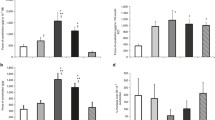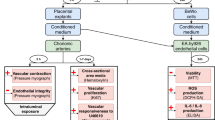Abstract
Objectives
eitFetoplacental blood vessels constrict in response to endothelin (ET-1) or reduced oxygen tension in the placental cotyledon perfused in vitro. In nonplacental resistance arteries, hypoxia and ET-1 induce constriction by promoting Ca influx into smooth muscle through membrane ion channels, which include voltage-gated Ca channels (VGCCs). We hypothesized that VGCCs are involved in ET-1— induced constriction of fetoplacental resistance vessels and that their contribution to constriction is enhanced at low oxygen tension.
Methods
eitChorionic plate small arteries from term placentas were studied using parallel wire myography. Arteries were normalized at 0.9 of L5.1 kPa (“low stretch” —25 mm Hg; approximating physiologic vascular pressure) or 0.9 of L133 kPa (“high stretch” — 42 mm Hg) and experiments performed at oxygen tensions of 156, 38, and 15 mm Hg.
Results
When chorionic plate arteries were normalized at low stretch, oxygen tension did not affect constriction to ET-1. Nifedipine (10 M), a blocker of L-type VGCCs, inhibited ET-1 (EC80eit)-induced constriction to a similar extent at each oxygen tension (52% to 64% inhibition). In contrast, when arteries were normalized at high stretch, constriction to ET-1 was greater at 38 than at 156 or 15 mm Hg oxygen and nifedipine inhibition of ET-1—induced constriction was greater at 38 and 15 mm Hg than at 156 mm Hg oxygen.
Conclusions
eitVGCCS and nifedipine-insensitive processes underlie the contractile response of chorionic plate arteries to ET-1 and their relative contribution to vasoconstriction is modulated by oxygen tension when vessels are normalized at high stretch. However, contrary to our hypothesis, the response of chorionic plate arteries to ET-1 is not modulated by oxygen when vessels are normalized at physiologic pressure.
Similar content being viewed by others
References
Haynes WG, Strachan FE, Webb DJ. Endothelin ETA and ETB receptors cause vasoconstriction of human resistance and capacitance vessels in vivo. Circulation 1995;92:357–363.
Sakata K, Ozaki H, Kwon SC, Karaki H. Effects of endothelin on the mechanical activity and cytosolic calcium level of various types of smooth muscle. Br J Pharmacol 1989;98:483–492.
Yanagisawa M, Kurihara H, Kimura S, et al. A novel protein vasocontrictor peptide produced by vascular endothelial cells. Nature 1988;332:411–415.
Myatt L, Langdon G, Bremer AS, Brockman DE. Endothelin-1 induced vasocontriction is not mediated by thromboxane release and action in the human fetal-placental circulation. Am J Obstet Gynecol 1991;165:1717–1722.
Wilkes BM, Mento PF, Hollander AM, et al. Endothelin receptors in human placenta: Relationship to vascular resistance and thromboxane release. Am J Physiol 1990;258:E864–E870.
Tsukahara H, Sekine K, Miura M, et al. Vasoactive and natriuretic mediators in umbilical cord blood: A report of our observation and review of the literature. Early Hum Dev 2002;69:57–64.
Kingdom JC, Burrell SJ, Kaufmann P. Pathology and clinical implications of abnormal umbilical artery Doppler waveforms. Ultrasound Obstet Gynecol 1997;9:271–286.
Trudinger BJ, Giles WB, Cook CM, Bombardieri J, Collins L. Fetal umbilical artery flow velocity waveforms and placental resistance: Clinical significance. Br J Obstet Gynaecol 1985;92:23–30.
Erdem A, Erdem M, Himmetoglu O, Yildirim G, Arslan M. Maternal and fetal plasma endothelin levels in intrauterine growth restriction: Relation to umbilical artery Doppler flow velocimetry. J Perinat Med 2003;31:52–59.
Luscher TF. Endothelin, Endothelin receptors and endothelin antagonists. Curr Opin Nephrol Hypertens 1994;3:92–98.
Masaki T. Historical review: Endothelin. Trends Pharm Sci 2004;25:119–224.
Mulvany MJ, Aalkjaer C. Structure and function of small arteries. Physiol Rev 1990;70:921–961.
Rutherford RAD, Wharton J, McCarthy A, et al. Differential localization of endothelin ETA and ETB binding sites in human placenta. Br J Pharmacol 1993;109:544–552.
Sand AE, Ostlund E, Andersson E, Fried G. Endothelin-induced contractions in placental arteries is mediated by both ETA- and ETB-receptors. Acta Physiol Scand 1998;163:227–234.
Miwa S, Iwamuro Y, Zhang X-F, et al. Ca2+ entry channels in rat thoracic aortic smooth muscle cells activated by endothelin-1. Jpn J Pharmacol 1999;80:281–288.
Callera GE, Bendhack LM. Mechanisms underlying the contractile response to endothelin-1 in the rat renal artery. Pharmacology 2003;68:131–139.
Fried G, Liu YA. Effects of endothelin, calcium channel blockade and EDRF inhibition on the contractility of human uteroplacental arteries. Acta Physiol Scand 1994;151:477–484.
Marinoni E, Picca A, Scucchi L, Cosmi EV, Di Iorio R. Immunohistochemical localisation of endothelin-1 in placental and fetal mambranes in term and preterm human pregnancy. Am J Reprod Immunol 1995;34:213–218.
Erdem M, Erdem A, Erdem O, et al. Immunohistochemical localization of endothelin-1 in human placenta from normal and growth-restricted pregnancies. Pediatr Dev Pathol 2003;6:307–313.
Remuzzi G, Perico N, Benigni A. New therapeutics that antagnonize endothelin: Promises and frustrations. Nat Rev Drug Discovery 2002;1:986–1001.
Levin ER. Endothelins. N Engl J Med 1995;333:356–363.
Thaete LG, Dewey ER, Neerhof MG. Endothelin and the regulation of uterine and placental perfusion in hypoxia-induced fetal growth restriction. J Soc Gynecol Investig 2004;11:16–21.
Boura AL, Leitch IM, Read MA, Walters WAW. The control of fetal vascular resistance in the human placenta. Troph Res 1998;11:299–313.
Byrne BM, Howard RB, Morrow RJ, Whiteley KJ, Adamson SL. Role of the L-arginine nitric oxide pathway in hypoxic fetoplacental vasoconstriction. Placenta 1997;18:627–634.
Howard RB, Hosokawa T, Maguire MH. Hypoxia-induced fetoplacental vasoconstriction in cotyledons of human term placentas: Antagonism by selected drugs. Pharmacologist 1984;26:144–4.
Read MA, Boura AL, Walters WA. Effects of variation in oxygen tension on responses of the human fetoplacental vasculature to vasoactive agents in vitro. Placenta 1995;16:667–678.
Ward JPT, Snetkov VA, Aaronson PI. Calcium, mitochondria and oxygen sensing in the pulmonary circulation. Cell Calcium 2004;36:209–220.
Hampl V, Biobova J, Stranak Z, et al. Hypoxic fetoplacental vasoconstriction in humans is mediated by potassium channel inhibition. Am J Physiol Heart Circ Physiol 2002;283:H2440–H2449.
Lackman F, Capewell V, Gagnon R, Richardson B. Fetal umbilical cord oxygen values and birth to placental weight ratio in relation to size at birth. Am J Obstet Gynecol 2001;185:674–682.
Burton GJ, Cannigia I. Hypoxia: Implications for implantation to delivery—A workshop report. Placenta 2001;22:S63–S65.
Kleiner-Assaf A, Jaffa AJ, Elad D. Hemodynamic model for analysis of Doppler ultrasound indexes of umbilical blood flow. Am J Physiol 1999;276:H2204–H2214.
Wareing M, Crocker IP, Warren AY, Taggart MJ, Baker PN. Characterization of small arteries isolated from the human placental chorionic plate. Placenta 2002;23:400–409.
Wareing M, Greenwood SL, Taggart MJ, Baker PN. Vasoactive responses of veins isolated from the human placental chorionic plate. Placenta 2003;24:790–796.
McCarthy AL, Woolfson RG, Evans BJ, et al. Functional characteristics of small placental arteries. Am J Obstet Gynecol 1994;170:945–951.
Mulvany MJ, Halpern W. Contractile properties of small arterial resistance vessels in spontaneously hypertensive and normotensive rats. Circ Res 1977;41:19–26.
Myatt L, Brewer A, Langdon G, Brockman DE. Attenuation of the vasoconstrictor effects of thromboxane and endothelin by nitric oxide in the human fetal-placental circulation. Am J Obstet Gynecol 1992;166:224–230.
MacClean MR, Templeton AG, McGrath JC. The influence of endothelin-1 on human foeto-placental blood vessels: A comparison with 5-hydroxytryptamine. Br. J Pharmacol 1992;106:937–941.
Le SQ, Wasserstrum N, Mombouli JV, Vanhoutte PM, Contractile effect of endothelin in human placental veins: Role of endothelium prostaglandins and thromboxane. Am J Obstet Gynecol 1993;169:919–924.
Fox SB, Khong TY. Lack of innervation of human umbilical cord. An immunohistological and histochemical study. Placenta 1990;11:59–62.
Howard RB. Control of human placental blood flow. Med Hypoth 1987;23:51–58.
Ward JP, Aaronson PI. Mechanisms of hypoxic pulmonary vasoconstriction: Can anyone be right? Respir Physiol 1999;115:261–271.
Cooper EJ, Wareing M, Baker PN, Greenwood SL. Effect of oxygen tension on nifedipine-induced relaxation of human placentral chorionic plate arteries. J Physiol 2003;555.P:C109–C109.
Shaw L, O’Neill S, Jones CJ, Austin C, Taggart MJ. Comparison of U46619-, endothelin-1 or phenyleprine-induced changes in Ca2+ profiles and Ca2+ sensitisation of constriction of pressurised rat resistance arteries. Br J Pharmacol 2004;141:678–688.
Peng W, Michael JR, Hoidal JR, Karwande SV, Farrukh IS. ET-1 modulates KCa channel activity and arterial tension in normoxic and hypoxic human pulmonary vasculature. Am J Physiol Regul Lung Cell Mol Physiol 1998;275:L729–L739.
Liu HS, Ostlund E, Fried G. Endothelin-induced contractions in human placental blood vessels are enhanced in intrauterine growth retardation, and modulated by agents that regulate levels of intracellular calcium. Acta Physiol Scand 1995;155:405–414.
Furuhashi N, Kimura H, Nagae H, Yajima A. Maternal plasma endothelin levels and fetal status in normal and preeclamptic pregnancies. Gynecol Obstet Invest 1995;39:88–92.
Author information
Authors and Affiliations
Corresponding author
Additional information
From the Maternal and Fetal Health Research Centre, St Mary’s Hospital, The Medical School, University of Manchester, Manchester, UK.
Supported by Tommy’s: the baby charity.
The authors are grateful to the midwives of the Central Delivery Unit at St Mary’s Hospital for their help in obtaining patient consent.
Rights and permissions
About this article
Cite this article
Cooper, E.J., Wareing, M., Greenwood, S.L. et al. Effects of Oxygen Tension and Normalization Pressure on Endothelin-lnduced Constriction of Human Placental Chorionic Plate Arteries. Reprod. Sci. 12, 488–494 (2005). https://doi.org/10.1016/j.jsgi.2005.05.004
Published:
Issue Date:
DOI: https://doi.org/10.1016/j.jsgi.2005.05.004




